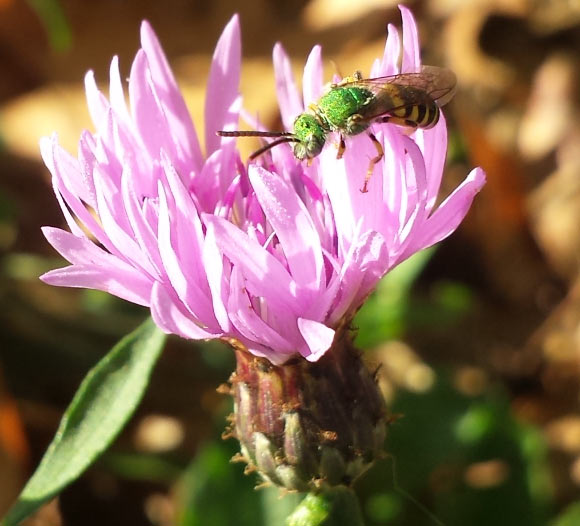For scores of wild bee species, females and males visit very different flowers for food, according to a new study published in the journal PLoS ONE.

The bicolored striped-sweat bee (Agapostemon virescens), a male, on spotted knapweed in the Rutgers-owned Hutcheson Memorial Forest in Franklin Township, Somerset County. Image credit: Michael Roswell / Rutgers University-New Brunswick.
“As we get a better sense of what makes flowers attractive to different kinds of bees, maybe we can get smarter about bee conservation,” said lead author Michael Roswell, a doctoral student at Rutgers University-New Brunswick.
In the study, Roswell and colleagues assessed differences between floral preferences of male and female bees in the field.
They collected bees foraging on flowers in semi-natural meadows in New Jersey, the United States.
“New Jersey is home to about 400 species of wild bees — not including Apis mellifera, the domesticated western honeybee whose males do not forage for food,” Roswell noted.
In total, the scientists collected 18,698 bee specimens belonging to 152 bee species from a total of 109 flower species.
Although the ratio of male to female bees was highly variable across bee species, roughly 18% of specimens were male.
The overall ratio of male to female bees the team collected was 0.22, although this ratio varied markedly between flower species.
“Female bees build, maintain, collect food for and defend nests, while male bees primarily seek mates,” Roswell and colleagues said.
“Both sexes drink floral nectar for food, but only females collect pollen that serves as food for young bees, so they forage at greater rates than males.”
“From the flowers’ standpoint, both female and male bees are important pollinators — though female bees are more prolific because they spend more time foraging at flowers.”
“Before mating, the males of some species travel from the area where they were born. Targeting their preferences for flowers may help maintain genetically diverse bee populations.”
“We see some intriguing patterns, where certain plant families seem relatively preferred or avoided by male bees, or where males have relatively less appetite for visiting flowers that only produce pollen and not nectar,” he added.
“That could help pinpoint the right mix of flowers to improve bee conservation down the road.”
_____
M. Roswell et al. 2019. Male and female bees show large differences in floral preference. PLoS ONE 14 (4): e0214909; doi: 10.1371/journal.pone.0214909







